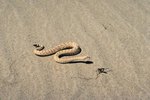Warnings
Never pick up a snake if you are unsure what kind it is. Venomous snakes can be deadly.
Snake identification is extremely important due to the fact that many snakes are highly venomous and even deadly to humans. Certain snakes have a similar appearance, making it difficult to know whether the snake is dangerous or not. There are many silver snakes that are harmless and even silver snakes that people keep as pets, such as a boa constrictor or ball python. There are many silvery snakes, however, that are venomous and dangerous, such as the sea crate or the water moccasin. Here is a guide for identifying an unknown silver snake.
Try to see how long the snake is. Length can be a helpful identifier in the snake world. Venomous snakes are most commonly over 3 feet in length, while harmless snakes are typically smaller when full grown. Do not pick up the snake to measure it, try to estimate. Picking up a snake that you have not identified is extremely dangerous because the snake could bite you.
Look at the shape of the snake. If the head shape is shaped like a diamond or looks boxy, then it cold be a venomous snake. Non-venomous snakes usually have a longer, leaner head. The body of a venomous snake is more likely to be thicker while a harmless snake is typically skinnier.
Look at the eyes. Venomous snakes will have slits in their eyes, similar to that of a feline. Harmless snakes, such as the ball python, have round pupils. This is a great identifier that can help you to determine whether the snake is dangerous if you cannot tell by the body shape or length. Do not get too close to the snake, however, try to see the eyes from a distance.
Resources
Warnings
- Never pick up a snake if you are unsure what kind it is. Venomous snakes can be deadly.





